Speech edited for length and introduction by James F. Maguire.
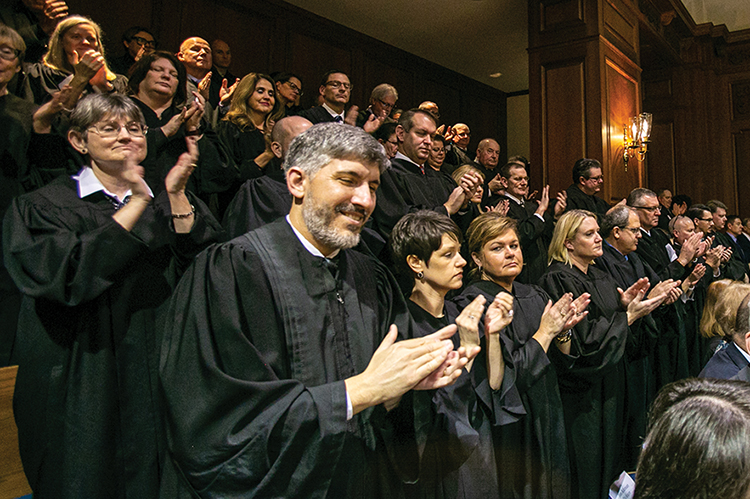
On January 15, 2020, Indiana Chief Justice Loretta H. Rush delivered her sixth address on the State of the Judiciary to a joint session of the Indiana General Assembly.
The Supreme Court justices and judges of the Court of Appeals were greeted by members of the House and Senate, including Representatives John Young, Greg Steuerwald, B. Patrick Bauer, and Edward DeLaney and Senators Eric Koch, Liz Brown, Karen Tallian, and Greg Taylor. A record number of judges (with over 100 from across the state), special guests, members of the media, and elected official from all branches of government were present. Lt. Gov. Suzanne Crouch called the session to order.
Chief Justice Rush reported that the state of the Indiana judiciary remains strong, thanks to the commitment of the courts to pursuing justice for all Hoosiers with energy and innovation. She highlighted the resolve of the judiciary to fighting the addiction epidemic, pursuing pretrial and criminal justice reform, and supporting and strengthening families.
Before her address, those gathered in the House chambers saw photographs of many problem-solving court graduates. Each one is a remarkable success, a life changed, and a person rejoining a community. Last year, Indiana reached a milestone by certifying its 100th problem-solving court.
Problem-Solving Courts
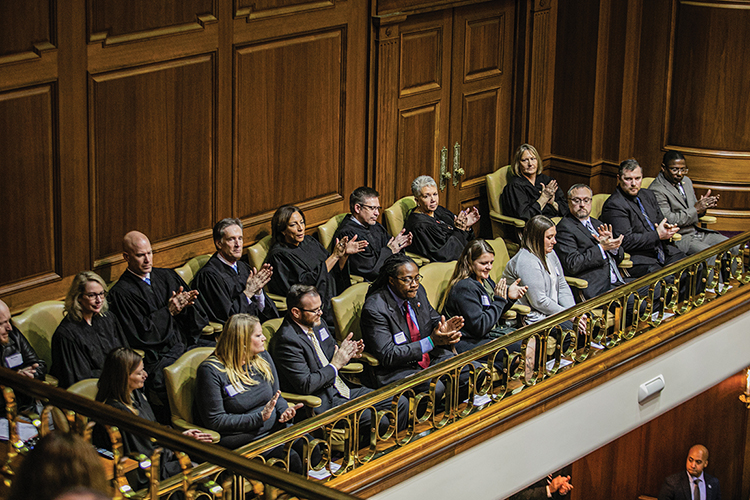
There are many types of these specialized courts: among them, veterans, drug, mental health, domestic violence, reentry, and family recovery courts. These courts work because judges get out from behind the bench, convene community partners, and truly connect with those standing before them in desperate need of a new path.
Pulaski County Judge Crystal Kocher developed a veterans treatment court last year after recognizing her rural community was being ravaged by methamphetamine and heroin, saying, “I wanted a non-adversarial approach to treating the drug and mental health epidemic. I knew we could be effective with a team approach to making our community better.”
Montgomery County Judge Peggy Lohorn says a once-lost soldier found his way back, thanks to the veterans court. In 2008, Army Specialist Jonathan Bushong was escorting a convoy of semis through Iraq when a roadside bomb exploded. While he escaped physically unharmed, he suffered from wounds that could not be seen. Once admitted to the veterans treatment court, his road to recovery was long and difficult, but he wasn’t alone.
In addition to the court team, General Wayne Black of the Indiana National Guard stepped up to serve as his mentor. Today, Jonathan is enrolled at Ivy Tech Community College, has reconnected with beloved family members, and intends to serve as a veterans court mentor.
Problem-solving courts are only possible with strong judicial leadership. And nowhere is this leadership more apparent than the role judges have in combatting the addiction epidemic.
After three years of co-chairing the National Judicial Opioid Task Force, Chief Justice Rush emphasized three truths: first, those with Opioid Use Disorder are 13 times more likely to be involved in the criminal justice system; second, the justice system is the single-largest referral source to get someone to treatment; and third, we must treat opioid and substance abuse disorders as chronic, treatable brain diseases—and not as moral failures.
This epidemic has caused our jail populations to increase. Under criminal justice and pretrial reform, lower-risk offenders should be released without having to post bail. Our courts should make use of all available information, including evidence-based risk assessments, to ensure that fairness prevails for all Hoosiers, regardless of wealth, geography, race, or gender.
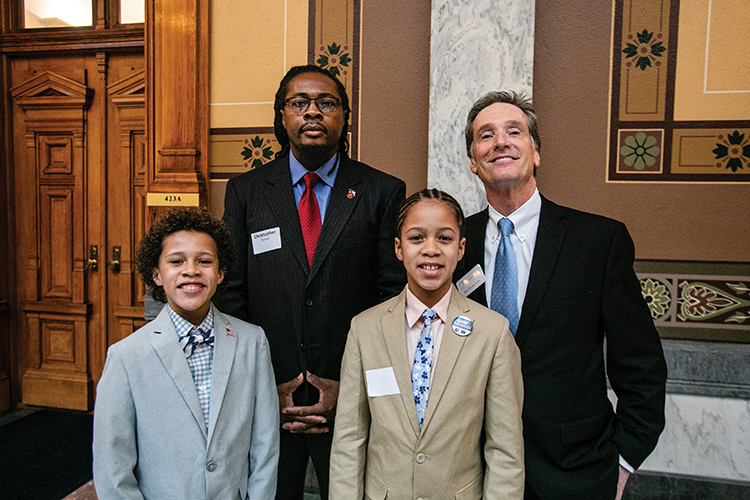
Pretrial & Criminal Justice Reform
Last October, over 700 justice partners from across Indiana convened to reform our State’s pretrial release procedures. Judges, sheriffs, prosecutors, public defenders, medical professionals, elected officials, probation officers, and others joined together to work on criminal justice reform in their communities.
Representative Greg Steuerwald has been a dedicated leader in providing solutions to fulfill that promise of justice in Indiana. In Martin County, Judge Lynne Ellis formed the Martin County Justice Coalition. They’ve developed a pretrial release matrix and are building a system that fits their own county culture.
Jail Overcrowding
The Jail Overcrowding Task Force was created to study the causes of and potential solutions for this very issue. Justice Steven David chaired the group composed of all three branches of government. Representative Randy Frye called the task force, “an historic joint effort which brought an eye-opening overview of this complex issue. It illustrates that by working together we can transform the lives of incarcerated Hoosiers.”
Supporting & Strengthening Families
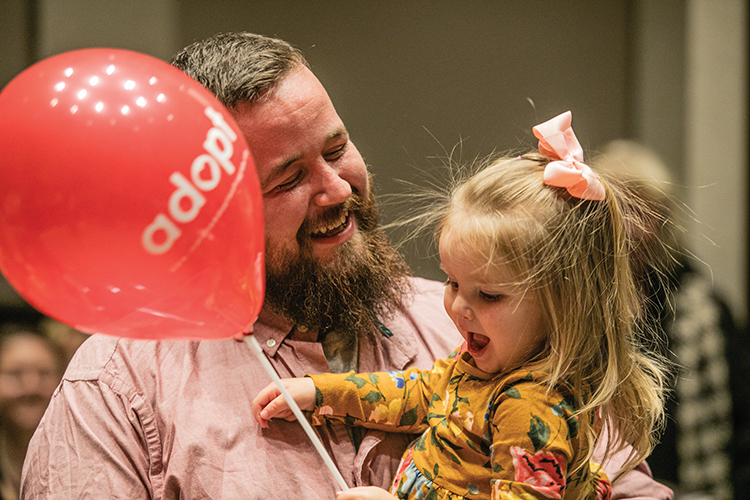
Strong families are the foundation of strong communities. Our courts focus on strengthening families who are under great stress and in many instances have endured unthinkable trauma.
In 2012, our Adoption Day event began with three judges and 50 children. For Adoption Day 2019, over 40 judges participated, and over 300 children celebrated in joining their forever families. In 2013, the Legislature established the Adult Guardianship Office. Today, adult guardianship programs are found in 49 counties, serving 800 endangered adults. In 2016, the Legislature increased CASA funding, which resulted in modernized operations, recording nearly one million hours of training and advocacy for children. Last year, over 4,500 volunteers in a record 86 counties served over 25,000 abused and neglected children.
Families are desperate for us to better respond to those with mental health challenges. In 2019, the Supreme Court sent a team to a mental health summit to tackle the underlying behavioral health issues that bring people to our courtrooms. Justice Christopher Goff, Senator Jack Sandlin, Sheriff Brett Clark, Doug Huntsinger, Jay Chaudhary, Justin Forkner, and Mary Kay Hudson attended the summit.
The Commission on Improving the Status of Children in Indiana, led by Director Julie Whitman, is in its seventh year and serves as a national model because all three branches are working together to promote the well-being of children. They address issues such as child trafficking, teen suicide, infant mortality, vaping, and school discipline.
We can do a better job of helping families with accessible legal representation through increased legal aid funding. And, Chief Justice Rush humbly requested legislative appropriations to accomplish this need.
The Coalition for Court Access continues to advance indianalegalhelp.org to provide self-help forms and connections to legal service providers. Last year Indiana lawyers contributed nearly a half million hours of volunteer legal services. And, Indiana law students recently logged 100,000 volunteer hours.
Court Modernization
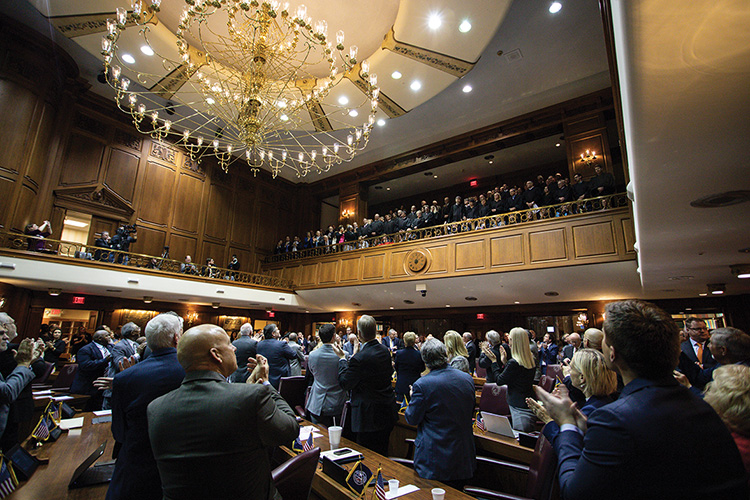
E-filing is occurring in every county with nearly a half-million documents being filed electronically each month. Our statewide case management system is operating in almost 80 counties. Free, online, public access to court cases is available through mycase.in.gov with more than 27 million visits a year. Courts can now send text messages to defendants in criminal cases, reminding them of their next court hearing.
To release the potential of Indiana’s judiciary, we created the Innovation Initiative. We are already national leaders in justice reform areas such as evidence-based decision-making, pretrial release, juvenile justice, problem-solving and commercial courts, along with court technology. But opportunities must be sought to make Indiana’s system of justice more efficient, less expensive, and easier to navigate, while continuing to ensure that justice is fairly administered, and the rights of all litigants are protected.
Civic Engagement
Our judges regularly take time to provide law-related civics education to thousands of students and community members through Constitution Day, mock trials, Statehood Day, We the People, and other civic events.
Our 15-member Court of Appeals has now held oral arguments in every single one of our 92 Indiana counties through their “Appeals on Wheels” program. They have developed relationships in over 500 communities, providing students at high schools, colleges, and law schools, guests at tourist sites, and retirement home residents, an opportunity to get up close and personal with their government.
Making History
One hundred years ago, women were finally able to vote. Last year for the first time in history, a number of Indiana Courts were led by women. In addition to the Supreme Court headed by Chief Justice Rush, these women judges also served: Jane Magnus-Stinson, Chief Judge of the U.S. District Court for the Southern District of Indiana; Theresa Lazar Springmann, Chief Judge of the U.S. District Court for the Northern District of Indiana; Robyn Moberly, Chief Judge of the U.S. Bankruptcy Court for the Southern District of Indiana; Martha Wentworth, Judge of the Indiana Tax Court; and Nancy Vaidik, who just completed her second term as Chief Judge of the Court of Appeals of Indiana.
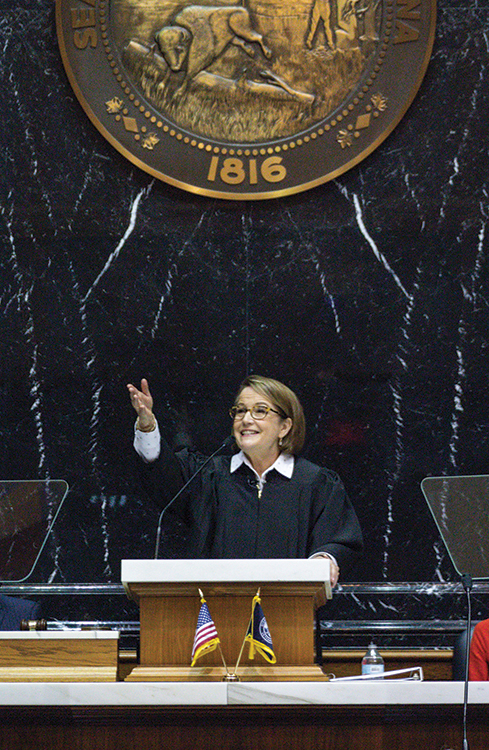
Conclusion
The framers of our constitution divided the power of government among three separate and co-equal branches. But that separation does not mean we should isolate ourselves from one another. Instead it calls for us to summon the very best in ourselves to walk that tightrope of equality without isolationism. And we’re doing it, listening to one another, helping one another, working toward common goals.